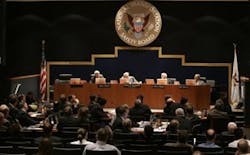Southwest Had Problems Reporting Runway Condition
Southwest Airlines pilots received differing reports on runway conditions as they approached Chicago's Midway airport, where their jet skidded off the runway and killed a 6-year-old boy, according to a cockpit transcript released Tuesday.
The National Transportation Safety Board is looking into procedures for landing at short or slippery runways as a result of the Dec. 8 accident. The jet, landing in snowy conditions, crashed through a fence into the street, killing Joshua Woods of Leroy, Ind., as he was riding in a car.
During Tuesday's NTSB hearing, safety officials were told that there is no single, reliable way to measure a runway's slickness in bad weather, making it hard for pilots to figure out how much room they need to land.
"It continues to be more of an art than a science," said Bill DeGroh, a safety representative for the Air Line Pilots Association, the largest pilots' union. The organization has urged the Federal Aviation Administration to develop a standard method of describing and reporting runway surface conditions.
Fifty-two minutes before the Boeing 737 touched down at Midway, the pilots were told runway conditions were "fair," with snow-covered taxiways. Nine minutes before touchdown, they got a report that conditions were "fair," except at the end, where they were "poor." Five minutes later, they were told conditions were "good" for the first half of the runway, "poor" for the second.
And one minute before touchdown - at 7:13 p.m. CST - they were told conditions were "fair to poor."
The pilots knew they couldn't land safely in poor conditions because there was a 9 mph tailwind; tailwinds of nearly 6 mph are Southwest's upper limit for a safe landing in poor conditions.
Southwest Airlines Co. now requires pilots to use the more restrictive condition when calculating how much room they need to land. If conditions are reported as "fair to poor," they must use "poor."
The FAA also set stricter standards for landings by passenger jets, starting Oct. 1.
Pilots will have to add 15 percent to the length of runway they think they need to land safely. They will also have to take the more conservative value when they receive differing reports on conditions.
The FAA has also given a $15 million grant to Midway to build soft concrete beds that can slow airplanes that overshoot runways.
The Midway runway, like many others at commercial airports in the United States, does not have a 1,000-foot buffer zone at the end for airplanes that overshoot their landings.
The FAA had identified 456 runways at U.S. airports that don't meet safety standards. As of August, 208 runways had been improved as much as they could be through various means - adding concrete beds, construction, buying more land or changing their layout - according to agency spokesman Les Dorr.
Congress passed a law last year requiring all runways to meet safety standards by 2015.
David Bennett, the FAA's director of Airport Safety and Standards, said the agency expects that deadline to be met.
During the flight, the pilots wrestled with the question of how they would land in bad weather at Midway, even considering other airports, according to the recording.
They even talked about crashing through the fence at Midway if their automatic brakes failed.
"No procedure if that sucker fails when you touch down?" said co-pilot Steven Oliver. "We just go through the fence? We never talk about any of that stuff, ya know?"
The recording revealed the unfolding drama in the cockpit as the plane skidded toward a fence.
"Son of a (expletive)," Capt. Bruce Sutherland said.
"Jump on the brakes, are ya?" Oliver said.
"Get that back there," Sutherland said moments later. "We ain't goin', man."
The pilots then told each other to "hang on" just seconds before the airplane crashed through the fence.
News stories provided by third parties are not edited by "Site Publication" staff. For suggestions and comments, please click the Contact link at the bottom of this page.

